利用Wireshark抓取并分析OpenFlow协议报文
OpenFlow 交换机与控制器交互步骤
1. 利用Mininet仿真平台构建如下图所示的网络拓扑,配置主机h1和h2的IP地址(h1:10.0.0.1,h2:10.0.0.2),测试两台主机之间的网络连通性
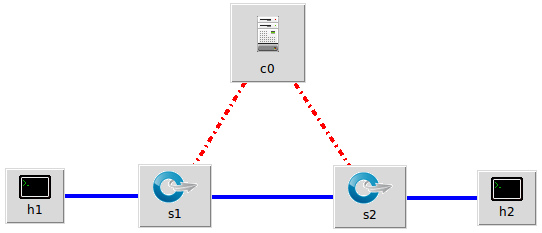
- miniedit.py设置
- start CLI
- 支持OpenFlow 1.0 1.1 1.2 1.3
- 其他使用默认设置(Controller选择默认的openflow reference)
2. 利用Wireshark工具,捕获拓扑中交换机与控制器之间的通信数据,对OpenFlow协议类型的各类报文进行分析,写出你的分析内容。
hello
控制器6633端口(我最高能支持OpenFlow 1.0) ---> 交换机35534端口

交换机35534端口(我最高能支持OpenFlow 1.3)---> 控制器6633端口

于是双方建立连接,并使用OpenFlow 1.0Features Request
控制器6633端口(我需要你的特征信息) ---> 交换机35534端口

Set Config
控制器6633端口(请按照我给你的flag和max bytes of packet进行配置) ---> 交换机35534端口

Features Reply
交换机35534端口(这是我的特征信息,请查收)--- 控制器6633端口
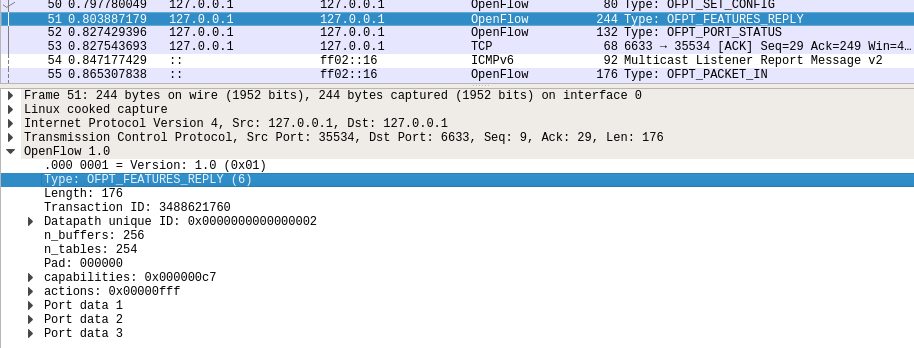
Features 消息包括 OpenFlow Header 和 Features Reply Message
对照Features Reply Message结构
struct ofp_switch_features{struct ofp_header header;uint64_t datapath_id; /*唯一标识 id 号*/uint32_t n_buffers; /*交缓冲区可以缓存的最大数据包个数*/uint8_t n_tables; /*流表数量*/uint8_t pad[3]; /*align to 64 bits*/uint32_t capabilities; /*支持的特殊功能,具体见 ofp_capabilities*/uint32_t actions; /*支持的动作,具体见 ofp_actions_type*/struct ofp_phy_port ports[0]; /*物理端口描述列表,具体见 ofp_phy_port*/};
对应到抓取到的报文,逐项查看报文内容
OpenFlow 1.0.000 0001 = Version: 1.0 (0x01)Type: OFPT_FEATURES_REPLY (6)Length: 176Transaction ID: 3488621760Datapath unique ID: 0x0000000000000002MAC addr: 00:00:00_00:00:00 (00:00:00:00:00:00)Implementers part: 0x0002n_buffers: 256n_tables: 254Pad: 000000capabilities: 0x000000c7.... .... .... .... .... .... .... ...1 = Flow statistics: True.... .... .... .... .... .... .... ..1. = Table statistics: True.... .... .... .... .... .... .... .1.. = Port statistics: True.... .... .... .... .... .... .... 0... = Group statistics: False.... .... .... .... .... .... ..0. .... = Can reassemble IP fragments: False.... .... .... .... .... .... .1.. .... = Queue statistics: True.... .... .... .... .... ...0 .... .... = Switch will block looping ports: Falseactions: 0x00000fff.... .... .... .... .... .... .... ...1 = Output to switch port: True.... .... .... .... .... .... .... ..1. = Set the 802.1q VLAN id: True.... .... .... .... .... .... .... .1.. = Set the 802.1q priority: True.... .... .... .... .... .... .... 1... = Strip the 802.1q header: True.... .... .... .... .... .... ...1 .... = Ethernet source address: True.... .... .... .... .... .... ..1. .... = Ethernet destination address: True.... .... .... .... .... .... .1.. .... = IP source address: True.... .... .... .... .... .... 1... .... = IP destination address: True.... .... .... .... .... ...1 .... .... = IP ToS (DSCP field, 6 bits): True.... .... .... .... .... ..1. .... .... = TCP/UDP source port: True.... .... .... .... .... .1.. .... .... = TCP/UDP destination port: True.... .... .... .... .... 1... .... .... = Output to queue: TruePort data 1Port number: 65534HW Address: e6:73:a1:3c:74:c0 (e6:73:a1:3c:74:c0)Port Name: s2Config flags: 0x00000001.... .... .... .... .... .... .... ...1 = Port is administratively down: True.... .... .... .... .... .... .... ..0. = Disable 802.1D spanning tree on port: False.... .... .... .... .... .... .... .0.. = Drop all packets except 802.1D spanning tree packets: False.... .... .... .... .... .... .... 0... = Drop received 802.1D STP packets: False.... .... .... .... .... .... ...0 .... = Do not include this port when flooding: False.... .... .... .... .... .... ..0. .... = Drop packets forwarded to port: False.... .... .... .... .... .... .0.. .... = Do not send packet-in msgs for port: FalseState flags: 0x00000001.... .... .... .... .... .... .... ...1 = No physical link present: TrueCurrent features: 0x00000000.... .... .... .... .... .... .... ...0 = 10 Mb half-duplex rate support: False.... .... .... .... .... .... .... ..0. = 10 Mb full-duplex rate support: False.... .... .... .... .... .... .... .0.. = 100 Mb half-duplex rate support: False.... .... .... .... .... .... .... 0... = 100 Mb full-duplex rate support: False.... .... .... .... .... .... ...0 .... = 1 Gb half-duplex rate support: False.... .... .... .... .... .... ..0. .... = 1 Gb full-duplex rate support: False.... .... .... .... .... .... .0.. .... = 10 Gb full-duplex rate support: False.... .... .... .... .... .... 0... .... = Copper medium: False.... .... .... .... .... ...0 .... .... = Fiber medium: False.... .... .... .... .... ..0. .... .... = Auto-negotiation: False.... .... .... .... .... .0.. .... .... = Pause: False.... .... .... .... .... 0... .... .... = Asymmetric pause: FalseAdvertised features: 0x00000000Features supported: 0x00000000Features advertised by peer: 0x00000000Port data 2Port number: 1HW Address: 2a:ca:66:29:0e:ae (2a:ca:66:29:0e:ae)Port Name: s2-eth1Config flags: 0x00000000.... .... .... .... .... .... .... ...0 = Port is administratively down: False.... .... .... .... .... .... .... ..0. = Disable 802.1D spanning tree on port: False.... .... .... .... .... .... .... .0.. = Drop all packets except 802.1D spanning tree packets: False.... .... .... .... .... .... .... 0... = Drop received 802.1D STP packets: False.... .... .... .... .... .... ...0 .... = Do not include this port when flooding: False.... .... .... .... .... .... ..0. .... = Drop packets forwarded to port: False.... .... .... .... .... .... .0.. .... = Do not send packet-in msgs for port: FalseState flags: 0x00000000.... .... .... .... .... .... .... ...0 = No physical link present: FalseCurrent features: 0x000000c0.... .... .... .... .... .... .... ...0 = 10 Mb half-duplex rate support: False.... .... .... .... .... .... .... ..0. = 10 Mb full-duplex rate support: False.... .... .... .... .... .... .... .0.. = 100 Mb half-duplex rate support: False.... .... .... .... .... .... .... 0... = 100 Mb full-duplex rate support: False.... .... .... .... .... .... ...0 .... = 1 Gb half-duplex rate support: False.... .... .... .... .... .... ..0. .... = 1 Gb full-duplex rate support: False.... .... .... .... .... .... .1.. .... = 10 Gb full-duplex rate support: True.... .... .... .... .... .... 1... .... = Copper medium: True.... .... .... .... .... ...0 .... .... = Fiber medium: False.... .... .... .... .... ..0. .... .... = Auto-negotiation: False.... .... .... .... .... .0.. .... .... = Pause: False.... .... .... .... .... 0... .... .... = Asymmetric pause: FalseAdvertised features: 0x00000000Features supported: 0x00000000Features advertised by peer: 0x00000000Port data 3Port number: 2HW Address: 66:01:64:ad:24:89 (66:01:64:ad:24:89)Port Name: s2-eth2Config flags: 0x00000000.... .... .... .... .... .... .... ...0 = Port is administratively down: False.... .... .... .... .... .... .... ..0. = Disable 802.1D spanning tree on port: False.... .... .... .... .... .... .... .0.. = Drop all packets except 802.1D spanning tree packets: False.... .... .... .... .... .... .... 0... = Drop received 802.1D STP packets: False.... .... .... .... .... .... ...0 .... = Do not include this port when flooding: False.... .... .... .... .... .... ..0. .... = Drop packets forwarded to port: False.... .... .... .... .... .... .0.. .... = Do not send packet-in msgs for port: FalseState flags: 0x00000000.... .... .... .... .... .... .... ...0 = No physical link present: FalseCurrent features: 0x000000c0.... .... .... .... .... .... .... ...0 = 10 Mb half-duplex rate support: False.... .... .... .... .... .... .... ..0. = 10 Mb full-duplex rate support: False.... .... .... .... .... .... .... .0.. = 100 Mb half-duplex rate support: False.... .... .... .... .... .... .... 0... = 100 Mb full-duplex rate support: False.... .... .... .... .... .... ...0 .... = 1 Gb half-duplex rate support: False.... .... .... .... .... .... ..0. .... = 1 Gb full-duplex rate support: False.... .... .... .... .... .... .1.. .... = 10 Gb full-duplex rate support: True.... .... .... .... .... .... 1... .... = Copper medium: True.... .... .... .... .... ...0 .... .... = Fiber medium: False.... .... .... .... .... ..0. .... .... = Auto-negotiation: False.... .... .... .... .... .0.. .... .... = Pause: False.... .... .... .... .... 0... .... .... = Asymmetric pause: FalseAdvertised features: 0x00000000Features supported: 0x00000000Features advertised by peer: 0x00000000
- Packet_in
交换机35534端口(有数据包进来,请指示)--- 控制器6633端口
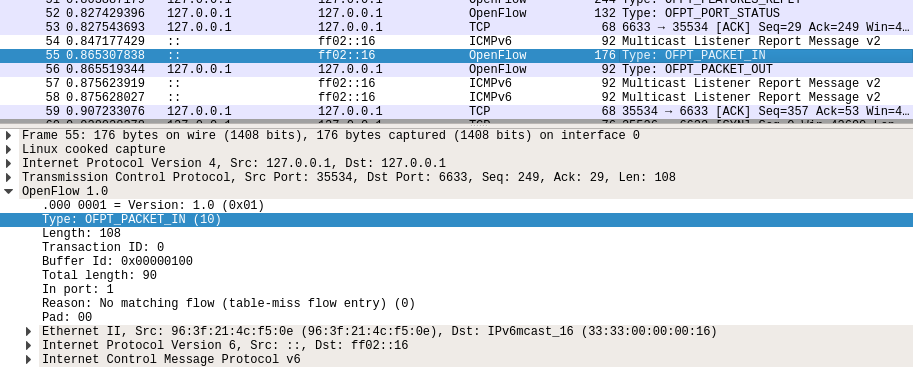
结合Packet_in的结构
struct ofp_packet_in {struct ofp_header header;uint32_t buffer_id; /*Packet-in消息所携带的数据包在交换机缓存区中的ID*/uint16_t total_len; /*data字段的长度*/uint16_t in_port; /*数据包进入交换机时的端口号*/uint8_t reason; /*发送Packet-in消息的原因,具体见 ofp_packet_in_reason*/uint8_t pad;uint8_t data[0]; /*携带的数据包*/};
分析抓取的数据包,可以发现是因为交换机发现此时自己并没有匹配的流表(Reason: No matching flow (table-miss flow entry) (0)),所以要问控制器如何处理
OpenFlow 1.0.000 0001 = Version: 1.0 (0x01)Type: OFPT_PACKET_IN (10)Length: 108Transaction ID: 0Buffer Id: 0x00000100Total length: 90In port: 1Reason: No matching flow (table-miss flow entry) (0)Pad: 00Ethernet II, Src: 96:3f:21:4c:f5:0e (96:3f:21:4c:f5:0e), Dst: IPv6mcast_16 (33:33:00:00:00:16)Destination: IPv6mcast_16 (33:33:00:00:00:16)Address: IPv6mcast_16 (33:33:00:00:00:16).... ..1. .... .... .... .... = LG bit: Locally administered address (this is NOT the factory default).... ...1 .... .... .... .... = IG bit: Group address (multicast/broadcast)Source: 96:3f:21:4c:f5:0e (96:3f:21:4c:f5:0e)Address: 96:3f:21:4c:f5:0e (96:3f:21:4c:f5:0e).... ..1. .... .... .... .... = LG bit: Locally administered address (this is NOT the factory default).... ...0 .... .... .... .... = IG bit: Individual address (unicast)Type: IPv6 (0x86dd)Internet Protocol Version 6, Src: ::, Dst: ff02::160110 .... = Version: 6.... 0000 0000 .... .... .... .... .... = Traffic Class: 0x00 (DSCP: CS0, ECN: Not-ECT).... 0000 00.. .... .... .... .... .... = Differentiated Services Codepoint: Default (0).... .... ..00 .... .... .... .... .... = Explicit Congestion Notification: Not ECN-Capable Transport (0).... .... .... 0000 0000 0000 0000 0000 = Flow Label: 0x00000Payload Length: 36Next Header: IPv6 Hop-by-Hop Option (0)Hop Limit: 1Source: ::Destination: ff02::16IPv6 Hop-by-Hop OptionNext Header: ICMPv6 (58)Length: 0[Length: 8 bytes]Router AlertType: Router Alert (0x05)00.. .... = Action: Skip and continue (0)..0. .... = May Change: No...0 0101 = Low-Order Bits: 0x05Length: 2Router Alert: MLD (0)PadNType: PadN (0x01)00.. .... = Action: Skip and continue (0)..0. .... = May Change: No...0 0001 = Low-Order Bits: 0x01Length: 0PadN: <none>Internet Control Message Protocol v6Type: Multicast Listener Report Message v2 (143)Code: 0Checksum: 0x7a2f [correct][Checksum Status: Good]Reserved: 0000Number of Multicast Address Records: 1Multicast Address Record Changed to exclude: ff02::1:ff4c:f50eRecord Type: Changed to exclude (4)Aux Data Len: 0Number of Sources: 0Multicast Address: ff02::1:ff4c:f50e
- Packet_out
控制器6633端口(请按照我给你的action进行处理) ---> 交换机35534端口

结合Packet_out的结构
struct ofp_packet_out {struct ofp_header header;uint32_t buffer_id; /*交换机缓存区id,如果为-1则指定的为packet-out消息携带的data字段*/uint16_t in_port; /*如果buffer_id为‐1,并且action列表中指定了Output=TABLE的动作,in_port将作为data段数据包的额外匹配信息进行流表查询*/uint16_t actions_len; /*action列表的长度,可以用来区分actions和data段*/struct ofp_action_header actions[0]; /*动作列表*/uint8_t data[0]; /*数据缓存区,可以存储一个以太网帧,可选*/}
告诉输出到交换机的65531端口
OpenFlow 1.0.000 0001 = Version: 1.0 (0x01)Type: OFPT_PACKET_OUT (13)Length: 24Transaction ID: 0Buffer Id: 0x00000100In port: 1Actions length: 8Actions type: Output to switch port (0)Action length: 8Output port: 65531Max length: 0
接下来是另一台交换机(端口35536)与控制器(端口6633)的交互过程
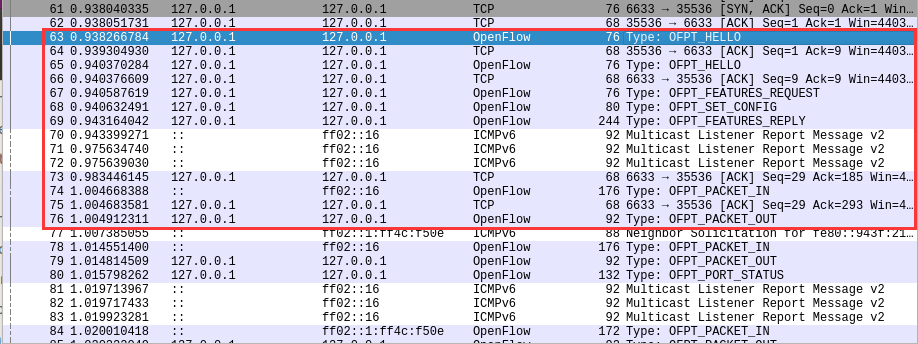
h1 ping h2
- packet_in
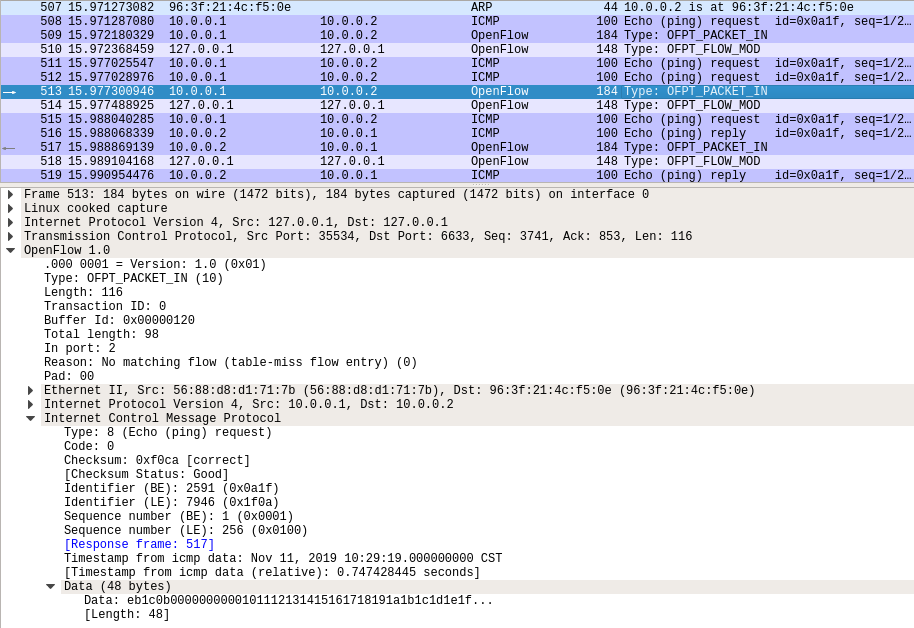
- flow_mod
结合flow_mod结构
struct ofp_flow_mod {struct ofp_header header;struct ofp_match match; /*流表的匹配域*/uint64_t cookie; /*流表项标识符*/uint16_t command; /*可以是ADD,DELETE,DELETE-STRICT,MODIFY,MODIFY-STRICT*/uint16_t idle_timeout; /*空闲超时时间*/uint16_t hard_timeout; /*最大生存时间*/uint16_t priority; /*优先级,优先级高的流表项优先匹配*/uint32_t buffer_id; /*缓存区ID ,用于指定缓存区中的一个数据包按这个消息的action列表处理*/uint16_t out_port; /*如果这条消息是用于删除流表则需要提供额外的匹配参数*/uint16_t flags; /*标志位,可以用来指示流表删除后是否发送flow‐removed消息,添加流表时是否检查流表重复项,添加的流表项是否为应急流表项。*/struct ofp_action_header actions[0]; /*action列表*/};
分析抓取的flow_mod数据包,控制器通过6633端口向交换机35334端口、交换机35336端口下发流表项,指导数据的转发处理
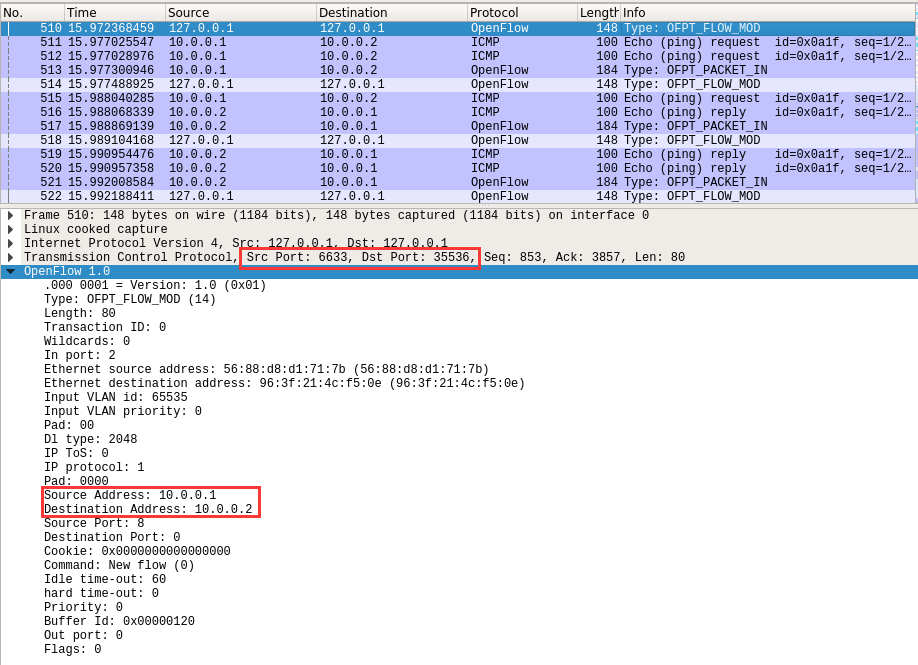
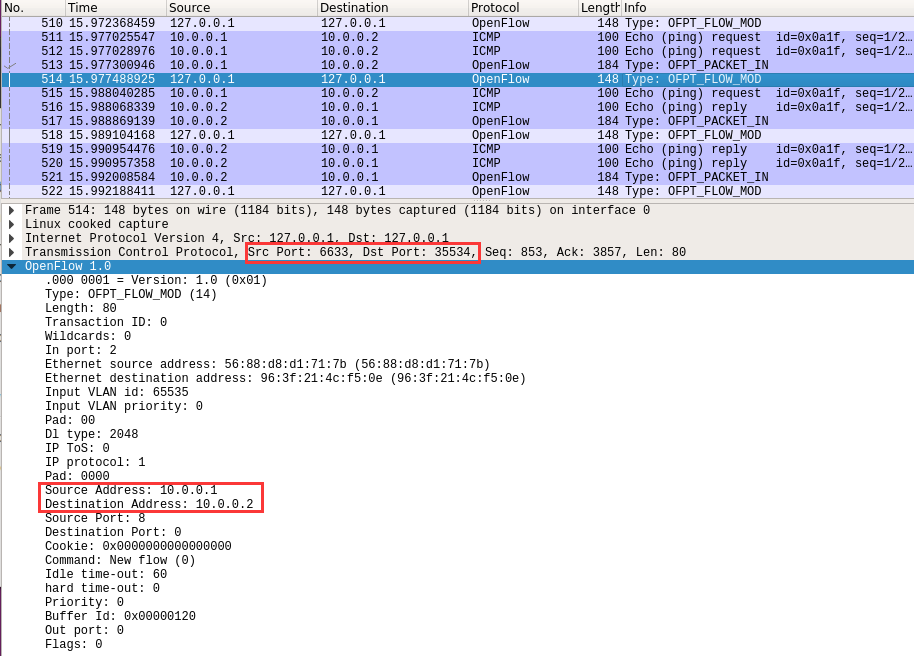
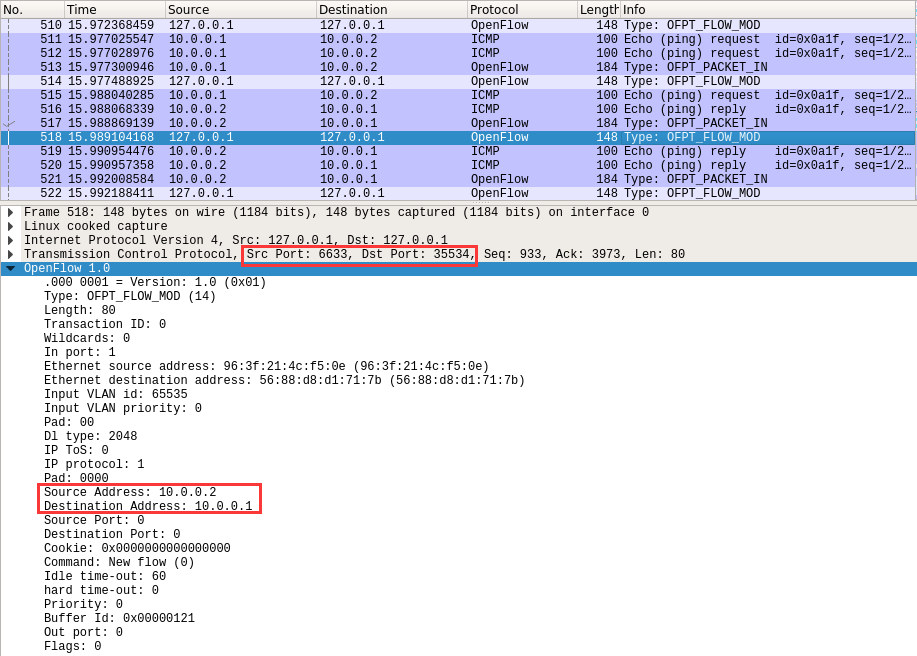
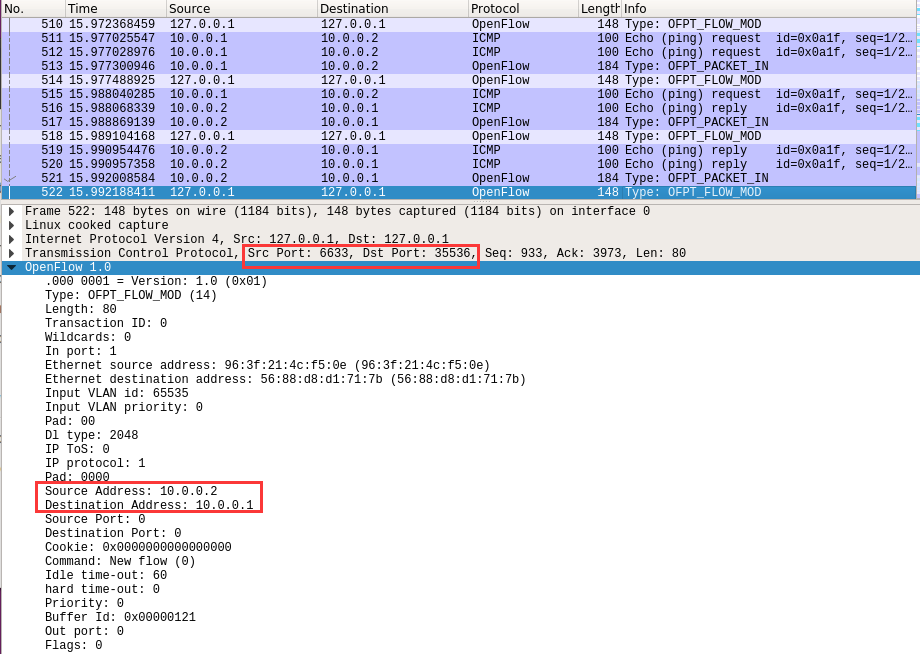
PS.把控制器从openflow reference改成ovs controller
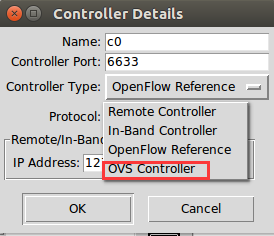
在hello报文中可以发现控制器支持的OpenFlow版本从1.0变成了1.3,因此,经过协商交换机和控制器之间将通过1.3版本的OpenFlow协议进行通信

- flow_mod

利用Wireshark抓取并分析OpenFlow协议报文的更多相关文章
- 利用wireshark抓取远程linux上的数据包
原文发表在我的博客主页,转载请注明出处. 前言 因为出差,前后准备总结了一周多,所以博客有所搁置.出差真是累人的活计,不过确实可以学习到很多东西,跟着老板学习做人,学习交流的技巧.入正题~ wires ...
- 利用wireshark抓取Telnet的用户名和密码
使用wireshark抓取Telnet 目标ip地址(telnet 192.168.88.1 ) 1,首先打开wireshark,然后选择网卡,点击开始. 2,为了在filter中输入telne ...
- 利用wireshark抓取TCP的整个过程分析。
原文地址:https://www.cnblogs.com/NickQ/p/9226579.html 最近,已经很久都没有更新博客了.看看时间,想想自己做了哪些事情,突然发现自己真的是太贪心,到头来却一 ...
- SNMP报文抓取与分析(二)
SNMP报文抓取与分析(二) SNMP报文抓取与分析(二) 1.SNMP报文表示简介 基本编码规则BER 标识域Tag表示 长度域length表示 2.SNMP报文详细分析(以一个get-respon ...
- Android利用tcpdump和wireshark抓取网络数据包
Android利用tcpdump和wireshark抓取网络数据包 主要介绍如何利用tcpdump抓取andorid手机上网络数据请求,利用Wireshark可以清晰的查看到网络请求的各个过程包括三次 ...
- 使用wireshark抓取TCP包分析1
使用wireshark抓取TCP包分析1 前言 介绍 目的 准备工作 传输 创建连接 握手 生成密钥 发送数据 断开连接 结论 前言 介绍 本篇文章是使用wireshrak对某个https请求的tcp ...
- Ubuntu下用wireshark抓取802.11封包并进行过滤分析
要用wireshark抓802.11的包 需要在linux下进行. 要在linux下抓802.11的包 需要在linux下安装无线网卡驱动. 所以 在正式抓取之前先把这两样东西搞起来. *没有特殊说明 ...
- 使用wireshark 抓取 http https tcp ip 协议进行学习
使用wireshark 抓取 http https tcp ip 协议进行学习 前言 本节使用wireshark工具抓包学习tcp ip http 协议 1. tcp 1.1 tcp三次握手在wire ...
- 深入理解USB流量数据包的抓取与分析
0x01 问题提出 在一次演练中,我们通过wireshark抓取了一个如下的数据包,我们如何对其进行分析? 0x02 问题分析 流量包是如何捕获的? 首先我们从上面的数据包分析可以知道,这是个USB的 ...
随机推荐
- arm9的中断
GPIO 习惯了stm32的GPIO,发现高端处理器arm在这方面反而简单了. ARM9控制GPIO只有三种寄存器. GPxCON:配置引脚功能,GPACON用一位控制一个GPIO,分别是0为输出引脚 ...
- SQL SERVER-修改实例的排序规则
系统库是无法直接修改的,只能修改用户数据库排序规则(要先解决依赖项.如表函数): ALTER DATABASE [xx] COLLATE Chinese_PRC_CI_AS 修改实例的排序规则,使用安 ...
- Android笔记(七十) AlertDialog
alertdialog可以在当前界面中弹出一个对话框,这个对话框在界面所有元素之上,可以屏蔽掉其他控件的交互能力,因此alertdialog常用于一些重要的内容警告. 使用AlertDialog.Bu ...
- ssh无密码连接
1. 生成密钥对文件 [root@centos2 ~]# -t 指定加密类型 -b 指定密钥对加密长度 询问1:执行过程中会询问保存位置,一般默认保存在当前用户家目录下的.ssh/目录下 询问2:是否 ...
- springboot项目搭建及常用技术整合
一.在你建立的工程下创建 Module 选择Spring initializr创建. 二.在Type处选择: Maven Project(项目的构建工具) 三.创建依赖时勾上web,mybatis,m ...
- 农业银行网上支付平台-商户接口编程-demo调试
调试的时候会报一个这样的错误. ReturnCode = [1999]ErrorMessage = [系统发生无法预期的错误 - 第1个证书无法读取证书文档] 网上其他资料说是权限问题,有的人可能是权 ...
- 2019-2020-1 20199301《Linux内核原理与分析》第四周作业
Week4 MenuOS的构造 一.上周复习 计算机的三大法宝: 存储程序计算机: 函数调用堆栈: 中断. 操作系统的两把宝剑: 中断上下文-保存现场和恢复现场 进程上下文 二.Linux内核源代码简 ...
- eclipse 安装反编译工具
jd-gui是我最喜欢使用的java反编译工具.它是一款用c++开发的轻量级的java反编译工具,无须安装即可以使用,你甚至都不需要安装jre环境就可以实现反编译:支持最新的jdk,目前是jdk 1. ...
- 面试官常问的20道Java题目(附答案)-来自Java1234
1. 以下代码的输出结果是(A) int i =3; i = i++; System.out.println(i); A .3 B.4 C.5 a=b++是先将b值赋值给a后b再自增. 2. Ma ...
- light,node.js,webStorm 安装项目搭建
light,是一个移动应用开发平台,旨在降低H5.APP的开发门槛.运维成本.提升移动应用产品的持续交付能力. 用light可以做什么 快速组织移动H5应用的协作开发.调试.应用发布,发布的应用可直接 ...
